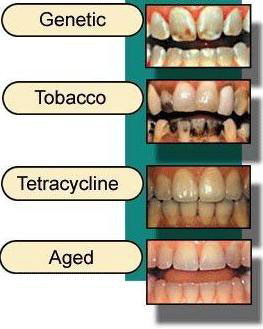IF your teeth are stained or discoloured, it is likely that you have gone to some lengths to achieve a whiter, brighter smile. Perhaps you have experimented with the variety of toothpastes on the market today and maybe purchased some of the home bleaching kits sold in drugstores and supermarkets. And who knows, in an attempt to draw attention away from your teeth, accentuated your hairstyle or clothing.
But unfortunately, many of these efforts ultimately fall short. Today, however, there is no need to suffer from social embarrassment or psychological trauma because of stained or discoloured teeth. Suitable cosmetic dental treatment can provide both predictable and positive long-term results.
There are a number of reasons that teeth stain. Foods, beverages, and medications may discolour teeth. Smoking or forgetting to brush and floss on a regular basis may also lead to staining. In other cases, discoloration may be the result of genetics or disease. Micro cracks caused by chewing ice or other hard objects can trap stains and are difficult – or more often impossible – to clean.
Cut back on coffee to reduce stains. Even with frequent cleanings, stains due to drinking large amounts of coffee may rapidly return. Now, what stains teeth? Stained teeth can be caused by drinking Coca Cola or Pepsi Cola, coffee, and tea. Also, by consuming other stain producing foods such as betel nuts, blueberries, red wine, or using tobacco the teeth can be stained. These stains are called surface stains.
You can stop staining your teeth by limiting the amount of black coffee and tea in your daily diet. Avoid smoking. Make regular visits to your dentist for professional cleanings and brush and floss regularly and properly. Some toothpastes have compounds that can help remove minor stains for a whitening effect.
Plaque can build up on teeth and cause stains, referred to as soft deposits. This is usually the result of inadequate oral hygiene (brushing and flossing). Surface stains occur primarily between teeth and on surfaces of crooked teeth. They are typically dark brown and are caused strong discolouring agents such as coffee, tea, and tobacco. It can usually be managed with daily oral hygiene combined with regular visits to your dentist for professional cleanings. Food colouring may be trapped in micro cracks and require a more aggressive treatment than professional cleanings alone (although bleaching can cause the micro cracks it become even whiter than or a different color from the rest of the tooth).
Soft deposits are caused by plaque – a sticky film that builds up on teeth over time – or tartar (calculus) – a cement-like substance that forms when plaque is not removed. They are often bacterial in origin and may be the by-product of ineffective oral hygiene. It can appear as dark or whitish areas around the gum line, most often on the lower front teeth and typically disappear after thorough dental scaling and polishing.
However, intrinsic stains are part of the tooth structure itself. This may be a result of genetics, disease, or the use of medications such as tetracycline. Intrinsic stains include white patches on the enamel surface and bands of brownish gray across the teeth. It may be caused by faulty hardening of the tooth before birth or the interruption of normal enamel formation by medications or disease. It often appears in people who were treated with the antibiotic tetracycline before the age of eight years or whose mothers tooth the drug while pregnant. it can also result from the use of the antibiotic minocycline or may be caused by advanced decay or by old or defective silver fillings (brown or gray stains).
Dr. BERTRAND R. STUART DDS.




.png)









